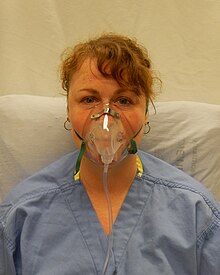Oxygen mask

An oxygen mask (engl. Oxygen mask ) is a device, the face or nose and mouth by the inhalation of pure oxygen to enable or a breathing gas mixture under difficult conditions. This includes reduced atmospheric pressure , a contaminated environment or hypoxia .
This type of mask is mostly used to guide the oxygen or breathing air mixture into the airways from a container with the help of a tube with a mask body attached to the end. The oxygen mask can be made of plastic , silicone or rubber . In addition to different manufacturer types, a distinction is made between full and half masks. In humans, the latter enclose the nose and mouth, while full masks also cover the eye area.
use
aviation
Oxygen masks are worn, among other things, by pilots whose aircraft do not have a pressurized cabin and who operate at altitudes where the organism is no longer adequately oxygenated due to the low partial pressure of oxygen. Even in military aircraft with a pressurized cabin, the crews may wear oxygen masks in order to remain able to act in the event of an accident with the possibly necessary activation of the ejection seat or under combat conditions.
On passenger aircraft, there are plastic oxygen masks in the cabin ceiling above each seat and on the toilet. If there is a loss of pressure in the aircraft cabin , a flap in the ceiling opens and the oxygen masks fall out of the cabin ceiling. The masks are connected to a chemical oxygen generator in the ceiling via a hose and activated by ignition by a rip cord from the passenger. For large aircraft like the A380 , a central supply via oxygen bottles is preferred for reasons of weight.
medicine
For short-term oxygen therapy, a mask made of flexible plastic is used, which is connected to an oxygen device on the supply tube. The fit of the mask is regulated with an adjustable elastic band. The mask encloses the nose and mouth, but there are openings on both sides. On some models, these are provided with valve flaps so that as little outside air as possible flows in to enable a high oxygen concentration. Such an oxygen mask is not a respiratory mask . However, depending on the fit of the mask and the oxygen dosage, an O 2 concentration of 40 to 60% is possible. The oxygen mask is used in emergencies, induction of anesthesia and in sleep apnea therapy.
The mask is unsuitable for long-term therapy because the patient cannot eat or drink with it and speech is impeded. With an oxygen cannula , the patient is less restricted.
Scuba diving
When scuba diving , no oxygen mask is actually worn. The dip or surge mask can mask as part unlike oxygen masks mouth free, but she closes her eyes with one. It is combined with a regulator , which is not supplied with pure oxygen, but breathing gas . The regulator is located in a separate mouthpiece that is connected to the compressed air device. The full face mask covers the whole face and has an integrated regulator.
Mountain sports
Oxygen masks are also used for extreme high-altitude mountaineering , mostly for climbing mountains with an altitude of more than 7,000 meters, in order to avoid the consequences of prolonged oxygen deficiency due to the thin air at high mountain levels.
Web links
Individual evidence
- ↑ A. Heuwinkel-Otter among others: People care. Springer Medizin Verlag, Heidelberg 2009, ISBN 978-3-540-79320-5 , p. 51.

